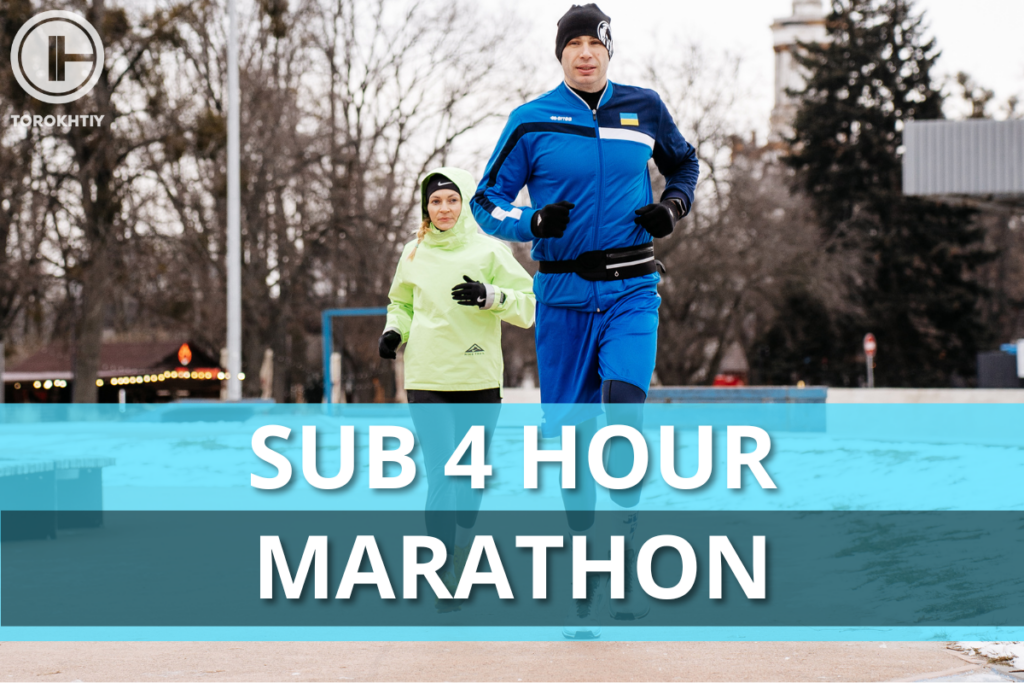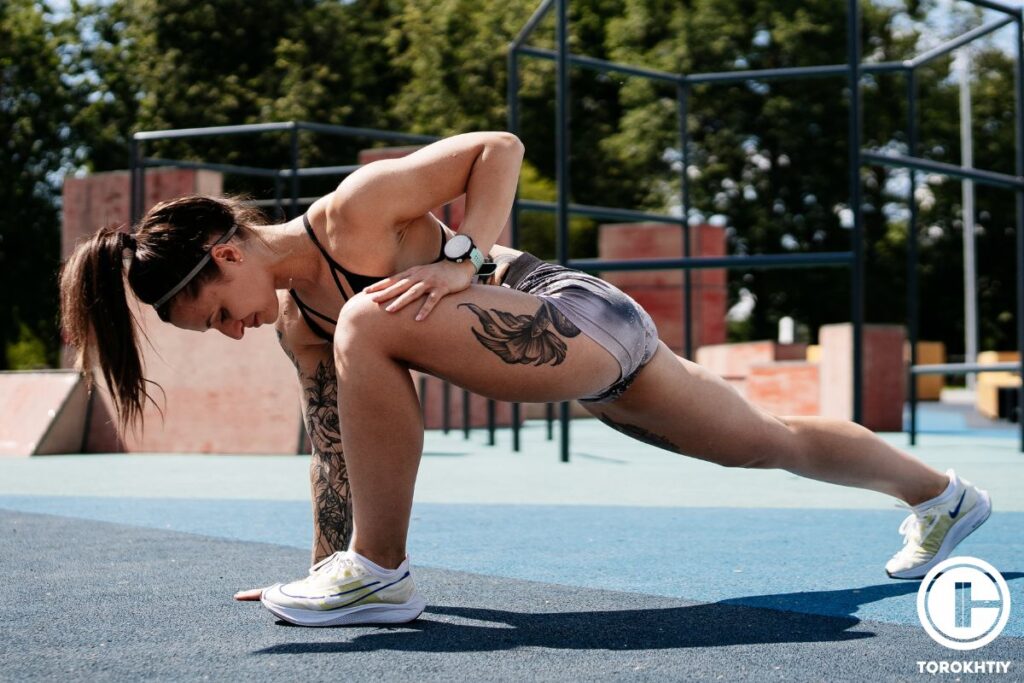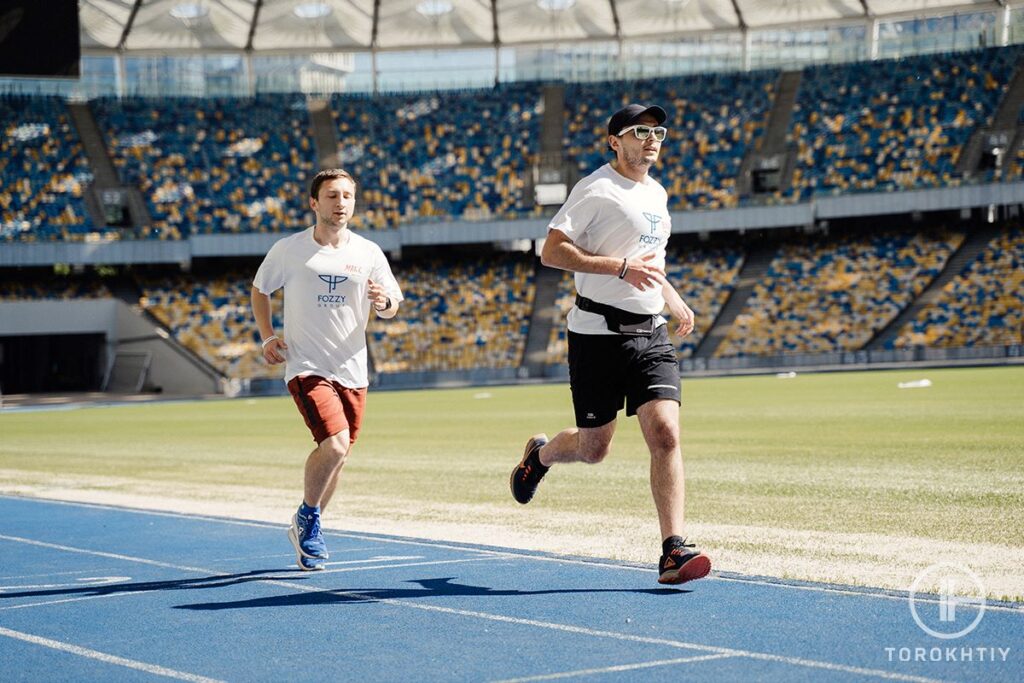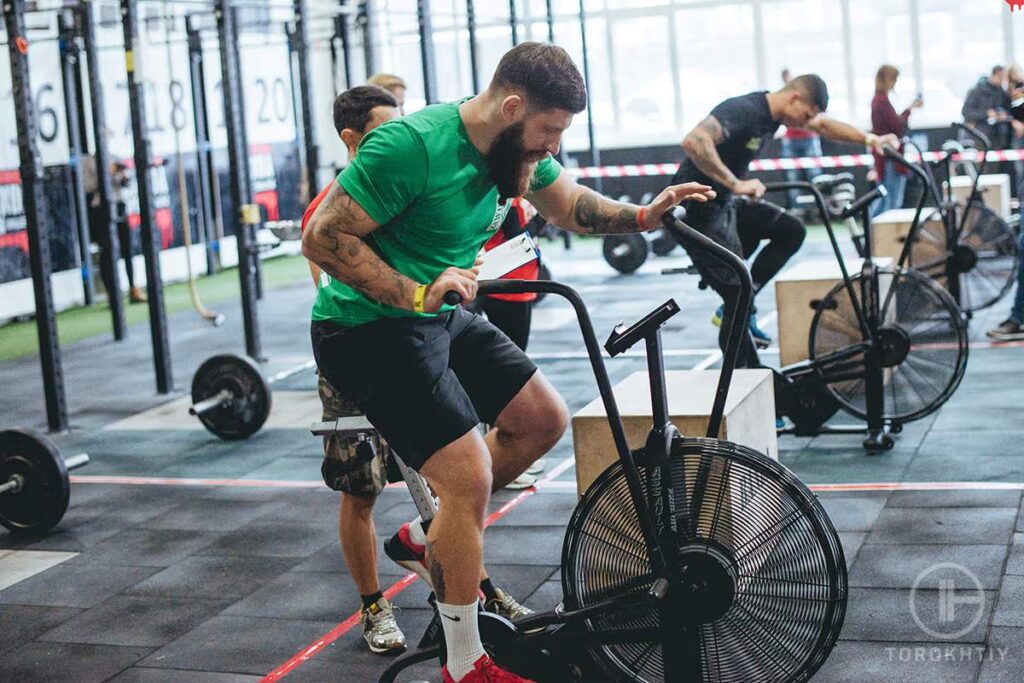Sub 4 Hour Marathon: Pace and Training Plan
Author:
Unlock your full potential by engaging with our experts and community! Have questions about your fitness journey or looking for expert advice on weightlifting techniques? Don’t hesitate — leave a comment below and Oleksandr Zagrebelnyi will provide a personalized answer and insights to help you reach your goals.
Torokhtiy is reader-supported. Some links are affiliate links, and we may earn a commission at no extra cost to you. See our disclosure page for details.
Are you planning on running a sub 4 hour marathon? This marathon is 26.2 miles long and most runners aim to reach the finish line with a time of 3:59:59. Hence, you need to choose a wise strategy to be able to complete this distance on time.
Your average pace should be around 9:09 minutes per mile (5:40 minutes per km) and your speed would be around 6.56 mph (17.04 kph). Read on to learn the ideal pace and what type of training you need to finish the marathon in 4 hours.
What Is A Good 4 Hour Marathon Pace? – The ideal pace for a 4 hour marathon is 9.09 minutes per mile. If a runner sustains this pace, they should reach the finish line within 4 hours. Although your mile time may be faster than this, it’s difficult to sustain a faster pace for the entire marathon.

How To Run A 4 Hour Marathon?
Being able to run a sub four hour marathon will take consistent training. This is something you will need to plan for several months ahead of time. Now, one question you might be wondering is “Should I focus on training to run faster or longer?”. To achieve the ideal sub 4 hour marathon pace, you will need to train for both.
When you begin training, your first goal should be to work on sustaining a 9.09 per mile pace. Instead of focusing on distance right away, your main target should be to sustain this pace for as long as you can. Many runners start by aiming to sustain this pace for 6 to 8 miles. Then they increase their mileage gradually once they can keep the pace controlled.
Of course, you shouldn’t completely avoid distance training. If you’re a beginner, it’s likely that you’re not used to running 26.2 miles. To get your body adapted to this distance, you should do a long run once a week leading up to the marathon. A long run for average runners is around 12-16 miles.
During this run, you’ll be focused on distance over speed, so it’s important to maintain a slower pace. As you train, you can gradually add more miles to your long run each week as your body adapts. However, you will need to eventually speed up your long runs to prepare for the marathon.
Once you’re used to running the long distance, aim to gradually increase your speed with your weekly long run.

What Pace Is A 4 Hour Marathon?
In order to run 26.2 miles in 4 hours, you will need to keep a pace of 9.09 minutes per mile. Your pace is the consistent speed that you maintain while running. Knowing your running pace can help you figure out how long it takes to cover a specific distance. It also allows you to judge whether or not you can sustain that pace for a set distance.
For example, if you were previously training to improve your mile speed, you may be able to run a mile in under 6 minutes. While you may be able to keep this pace for 1 or 2 miles, 26 miles is a completely different situation.
Your four hour marathon pace needs to be consistent. One mistake that a lot of new runners make is going too fast too soon. This can lead to them feeling tired long before they reach the finish line. Your performance will be a lot better if you start off at a slower pace. As your body embraces the movement, you can pick up the speed.

How Far Ahead Of Time Should I Start Training For A 4 Hour Marathon?
The average runner will need at least 16 to 22 weeks to train for a 4 hour marathon. If you’re a beginner with big goals, you may need to give yourself even longer to prepare. There are some runners that need around a year of training to meet this goal.
Even experienced runners should get a minimum of 16 weeks for preparation. It’s important to get as much practice holding your pace for the 4 hour marathon as you can so your body can adapt to holding the pace. If your body is not adapted, you could risk injury or burnout before you complete the marathon.
If you’re not an experienced runner, you can benefit by planning more than 22 weeks of training. Just because you’re new, doesn’t mean this goal isn’t attainable. However, you do need to set realistic goals. Preparing for this marathon means several months of smart training and hard work.
8 Stages Of Preparation For Training
When you train to improve your 4 hour marathon pace per mile, you won’t be doing the same routine every day. It’s important to challenge yourself to different running workouts in your training. This is because each one is effective for helping your body prepare. Let’s take a look at the different stages of training for a 4 hour marathon.
1. Importance of Warm-Ups
Every training session should start with a warm-up. When you warm up before a run, you help prepare your cardiovascular system. The activity will increase your body temperature, which increases the blood flow to your muscles. This is important before any type of running exercise because it reduces the risk of muscle soreness and injuries.
Your warm-up doesn’t have to be intense. It’s simply to help your body prepare for the work it’s about to do. Before going for a run, you should do approximately 10 minutes of joint warm-ups and light running activities.

2. Tempo Running
Your sub 4 hour marathon training plan will need to include tempo running. This type of training is performed to help a runner’s body get used to running faster paces for longer distances. This is exactly what you need to focus on doing to complete a four hour marathon.
When performing tempo training, you will choose a specific time and aim to sustain the speed for that timeframe. If you’re just beginning, you may aim to sustain a 9.09-minute mile speed for 20 minutes. Then gradually increase the timeframe as your body adapts.
The rule of thumb for tempo training is that your run needs to be comfortably challenging. This means that the runner should be further challenged with each run, but not to the point where they could burn out.
3. Long Run
A long run should be included in your training plan. When it comes to this goal, always be patient. Your body is not a machine and will not automatically go further and faster than it’s used to. You need to gradually increase the distance you’re running.
With your long run training, your first goal should be to work on running the 26.2 mile distance. Always start slow and easy to get this distance accomplished. Once your body is used to going this distance, you can start to increase the speed of your pace.
This is why it’s important to give yourself enough time for training, even if you need longer than what was suggested before. Once you have gotten your body adapted to running 26.2 miles during your long run, you will want to work on increasing the speed to prepare for an under 4 hour marathon.

4. Do You Need To Run Inclines?
Will there be hills in your marathon run? If so, then you should be practicing incline running. Ideally, you should train on hills that are a similar size to what will be in the marathon. Hills can be included in your tempo or interval training. Here is what you need to do:
- Run uphill at a 9.09-minute-mile pace.
- Jog downhill.
5. Cross Training
You will also need to include cross-training in your plan. Cross-training is important because you can build up your strength and endurance. The stronger you are going into the marathon, the easier it will be for you to maintain a 4 hour mile pace without getting burnt out.
When coming up with a cross-training plan, you will need to include strength workouts and speed workouts. This can include activities such as:
- Rowing;
- Biking/cycling;
- Weight lifting;
- Lunges;
- Squats;
- Pilates;
- Yoga;
- Swimming.

6. Always Cool-Down
Always complete a training session with a cool down. When you complete a run, you will likely be hot and sweaty. This is because exercise raises your body temperature. Your blood vessels will be dilated and your heart will be beating faster. If you immediately stop exercising when your body is in this state, you could feel sick or pass out.
After your run, you should gradually start a cool-down to regulate your body temperature. This should include 10 to 15 minutes of light running and stretching. Stretches are important because they help to accelerate recovery, improve your range of motion, and prevent muscle soreness.
7. Hydration – Before & After
Now that you know more about how to train your body for the run, let’s talk about how you can prepare it. Hydration is very important for running. Since running raises your body temperature, you will sweat and lose fluids. Drinking enough water is critical to replace fluid loss and prevent dehydration.
If runners become dehydrated, their performance and health will be at risk. Dehydration could lead to the following symptoms:
- Muscles cramps;
- Poor coordination;
- Fatigue;
- Headache;
- Nausea;
- Heat-related illnesses.

All of the above symptoms can be avoided by drinking enough water. Runners should follow the before-during-and-after rule when it comes to water.
- Drink 8 to 16 ounces of water 30 minutes before you run.
- For any run longer than 15 minutes, bring a bottle of water to drink during.
- Drink 8 to 16 ounces of water or other hydrating beverage once you have completed the run.
8. Nutrition – Before & After
Similar to hydration, your nutrition is also important for your performance. Think of the food you eat as the fuel you need to keep you going. This is why it’s important to eat a well-balanced diet that includes fresh produce, lean protein, and carbohydrates.
It’s recommended to eat carbohydrates before you run because they help provide you with energy and keep you alert. Runners who eat a carbohydrate snack approximately 30 minutes before a run tend to have better speed and endurance. These are some of the best snacks to fuel on before a marathon run:
- Yogurt with fruit and granola;
- Oatmeal with fruit;
- Toast or bagel with peanut butter (or almond butter);
- Sweet potato or squash;
- Granola bar.
Eating a snack or drinking a smoothing after the run can help you with recovery. Your post-run snack should be protein-rich. Protein provides your body with amino acids that help repair your muscles after a workout.
If you’re actively training for a marathon, you may need to increase your protein intake. Active people should aim to consume between 1.2 to 2 grams of protein per kilogram of body weight.
To get protein after a run, you don’t have to cook a steak or order a burger. You simply need a small snack to replenish your muscles. One of the most common go-to post-workout snacks for runners is a protein smoothie.
If you don’t have protein powder, you can make a protein-rich smoothie with banana, peanut butter, and other ingredients of your choice. Some other great post-run snacks include:
- A handful of almonds or nuts;
- Puffed rice cake with peanut butter;
- Lean meat and fresh vegetables on a tortilla wrap;
- Cheese and crackers;
- Salad with chicken, egg, or tuna.
Training Plan For A Marathon In 4 Hours
Now that you’re informed on what you need to do to train for this marathon, it’s time to talk about creating a 4 hour marathon training plan.
When making your plan, you should decide how many miles you want to run per week and use that to choose your workouts. Ideally, you should start with a realistic number, such as 20 miles in week 1, and gradually increase each week until the marathon.
Let’s take a look at an example of how you can plan for your sub 4 hour marathon training for the first month.
Week 1 – 20 Miles
| Day | Training |
|---|---|
| Monday | 3-mile intervals run (run 9:09-minute-mile pace for 1 minute, jog for 1 minute, repeat) |
| Tuesday | Strength training |
| Wednesday | 5-mile tempo run |
| Thursday | Rest or jog |
| Friday | 2-mile intervals run (run 9:09-minute-mile pace for 1 minute, jog for 1 minute, repeat) |
| Saturday | 10-mile long run |
| Sunday | Rest or jog |
Week 2 – 22 Miles
| Day | Training |
|---|---|
| Monday | 4-mile tempo run |
| Tuesday | Strength training |
| Wednesday | 5-mile tempo run |
| Thursday | Rest or jog |
| Friday | Speed training. 8 laps around a 4–meter track |
| Saturday | 11-mile long run |
| Sunday | Rest or jog |
Week 3 – 25 Miles
| Day | Training |
|---|---|
| Monday | 5-mile tempo run |
| Tuesday | Strength training |
| Wednesday | 3-mile tempo run |
| Thursday | Strength training |
| Friday | 5-mile tempo run |
| Saturday | 12-mile long run |
| Sunday | Rest or jog |
Week 4 – 27 Miles
| Day | Training |
|---|---|
| Monday | 4-mile tempo run |
| Tuesday | 5-mile tempo run |
| Wednesday | Strength training |
| Thursday | 5-mile tempo run |
| Friday | Strength training |
| Saturday | 13-mile long run |
| Sunday | Rest or jog |
What Are Rest Days & What You Should Do During Them?
Rest days are important because your muscles need time to recover after workouts. If you don’t take rest days between training sessions, you could risk injury or exhaustion. This can have a negative effect on your performance.
Now, a rest day doesn’t mean that you have to stay on the couch relaxing. You should still aim to enjoy light to moderate-intensity exercises that day. This should be an activity that keeps you moving but doesn’t put too much stress on your body. Some great rest day activities include swimming, yoga, pilates, or even a light jog.
How Do You Know When You’re Ready To Run A 4 Hour Marathon?
You may have no trouble holding a 9.09-minute-mile pace, but does this mean you’re ready to run the 4 hour marathon? Here are a few things you should be able to do to know that you’re ready.
- You can run 2 miles in 15 minutes without feeling tired or discomfort.
- Your 5k time is below 24:30.
- You can complete half the marathon’s distance with a time of 1:53:30 or better.
Hoka Bondi 8
- Material: Breathable and supportive mesh upper
- Sole Material: Full-length EVA midsole for maximum cushioning
- Outsole (tread feature): Durable rubber outsole with a unique lug pattern
- Drop: 4mm
- Season: Suitable for all seasons
- Special Features: Exceptional cushioning and comfort
- Size: Available in various sizes
- Type: Maximum cushioning running shoe
If you want excellent running or walking shoes or just footwear you’ll be comfortable in, you can’t go wrong with the Hoka Bondi 8.
It’s been upgraded and now they have lighter, softer materials and a new extended heel design. The heel design gives a super soft, balanced feeling from th emoment your heel hits the ground to when you push off with your toes.
As far as the weight goes, it’s around 10.80 ounces, and the heel drop is 4 mm. They’re not too heavy and the lower drop is a good balance between cushioning and feeling connected to the ground.
The Bondi 8 is focused on cushioning and keeps things simple. There’s a good amount of support without any extra stuff that you don’t really need and that would only jack up the price. Take the rear crash pad, for example – it makes for a soft, smooth ride, which is perfect if you like to run outdoors.

The upper part is made of engineered mesh, which is breathable and keeps your feet cool and dry. The tongue and collar have memory foam and mold to your foot shape. All of these features make the fit snug but flexible, which is exactly what you would want.
The Bondi 8 is eco-friendly because it uses recyclable materials in parts like the mesh and the sockliner. Plus, the shoes are completely vegan, which (if that’s important to you) is nice!
Frequently asked questions about training for a 4-hour marathon
Let’s look at the answers to the questions that runners are also interested in when preparing for a 4-hour race.
How can I avoid injury during a marathon?
Always perform a warm-up before your run to prepare your muscles and a cool-down afterward. Make sure you are wearing proper running shoes. You should also maintain your form and be able to breathe naturally.
What should I eat during marathon training?
Your diet doesn’t have to be restricted as long as you’re eating well-balanced meals. Make sure you eat fresh fruits and vegetables, lean protein, and carbohydrates to fuel your body.
What to do if you missed a week of your marathon training plan?
If you miss a week, you don’t have to start at the beginning. Simply lower the volume of your training by 10% and gradually increase it from there as you’re ready.
Conclusion
To finish a marathon in 4 hours, you must maintain a speed of 9:09 minutes per mile. The average runner will need 16 to 22 weeks to prepare for this marathon. However, some runners will need more time to get used to the speed and distance.
Are you preparing for a sub-4-hour marathon? Let us know your story in the comments below.
References:
- Aerobic exercise: How to warm up and cool down // Mayo Clinic: https://www.mayoclinic.org/healthy-lifestyle/fitness/in-depth/exercise/art-20045517
- Warm Up, Cool Down // American Heart Association: https://www.heart.org/en/healthy-living/fitness/fitness-basics/warm-up-cool-down
- Fluids and hydration in prolonged endurance performance // PubMed: https://pubmed.ncbi.nlm.nih.gov/15212747/
- Nutrition rules that will fuel your workout // Mayo Clinic: https://www.mayoclinic.org/healthy-lifestyle/nutrition-and-healthy-eating/in-depth/nutrition-rules-that-will-fuel-your-workout/art-20390073
- Photos by Torokhtiy Media Team.
Why Trust Us?
With over 20 years in Olympic weightlifting, strength training, nutrition coaching, and general fitness our team does its best to provide the audience with ultimate support and meet the needs and requirements of advanced athletes and professional lifters, as well as people who strive to open new opportunities and develop their physical capabilities with us.
By trusting the recommendations of our certified experts in coaching, nutrition, and sports training programming, as well as scientific consultants, and physiotherapists, we provide you with thorough, well-considered, and scientifically proven content. All the information given in the articles concerning workout programming, separate exercises, and athletic performance, in general, is based on verified data.
The product testing process is described in more detail here.
Oleksandr is a running coach and member of the Nike Run Club coaching team for 8 years. A participant in national and international competitions at distances from one kilometer to the ultra trail. Owner of mountain trail running camps. Nowadays Oleksandr is responsible for creating running training programs for athletes of various levels, coaching personally offline and online, conducts trail running camps in the mountains, participates in competitions.




Still have questions after reading our article? Unlock your full potential by engaging with our experts and community! Don’t hesitate — leave a comment below and Oleksandr Zagrebelnyi will provide a personalized answer and insights to help you reach your goals.